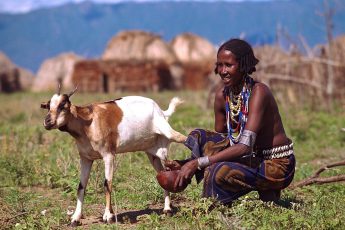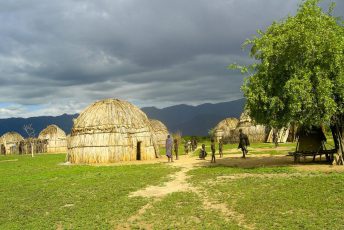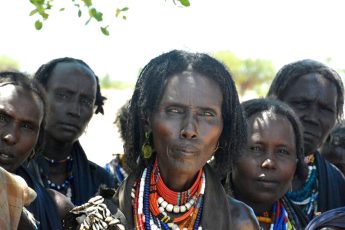From Girl to Woman
Without Exception
Ingó explained to me: Wannit macchina warrita. This means: Women are the machines of the family.
Rhythm
Child, Girl, Woman, Mother
The rhythm of work of the Arbore is defined by day and night, rainy and dry periods, the rhythm of a human life by the individual stages of socialization. With child - boy/girl - husband/wife - father/mother they are very similar to ours.
Newborns and very young children are referred to as morqo. They are not considered individuals. A girl is called haraté at the age of about 3. There is no ritual for this transition. With the stage of haraté, integration into the labor process begins, as well as the commandment to cover first their shame and later their buttocks. The biological mother, like her aunts, cousins or older sisters, is addressed only as ingó. This means my mother's sister, in other words, aunt.
At some point, a haraté gets married. Sometimes it is love, sometimes an arrangement. With sud (marriage), the first and great rite of passage, the girl becomes a bride, a status she maintains for many months. She moves in to her parents-in-law, where she is tested to see if she is being decent and diligent as well. After months, the final wedding ritual min gussin (house building) follows. Finally, after the highly ritualized wedding night, the bride is called sallé (wife). She is now called ege hanni, mother of the youngest. These are advance praises of what she will be soon.
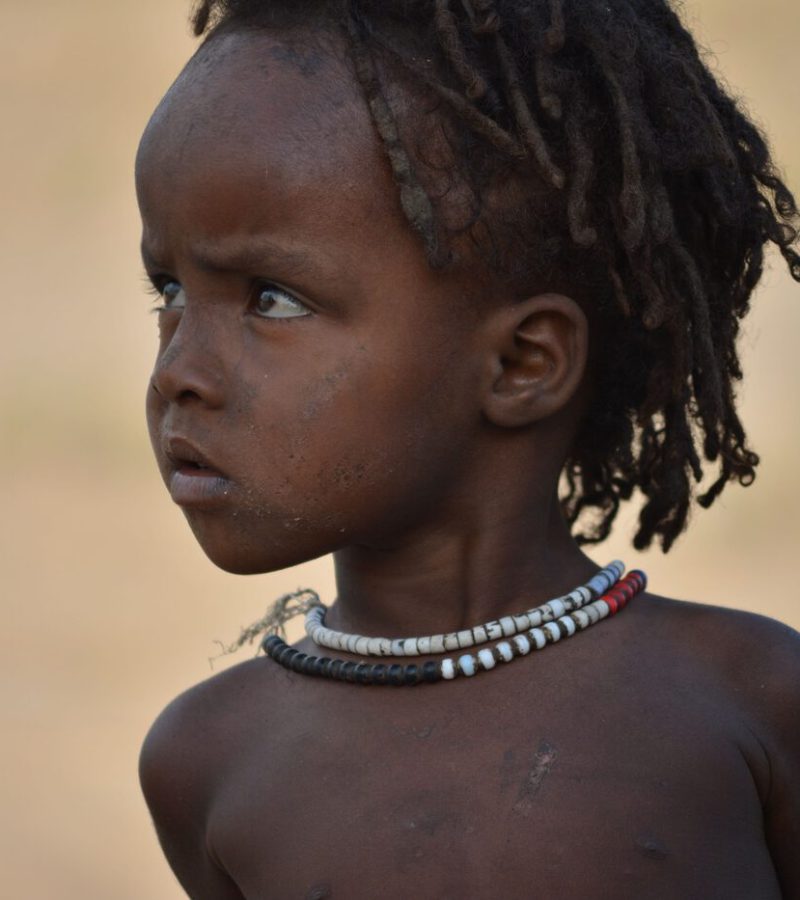
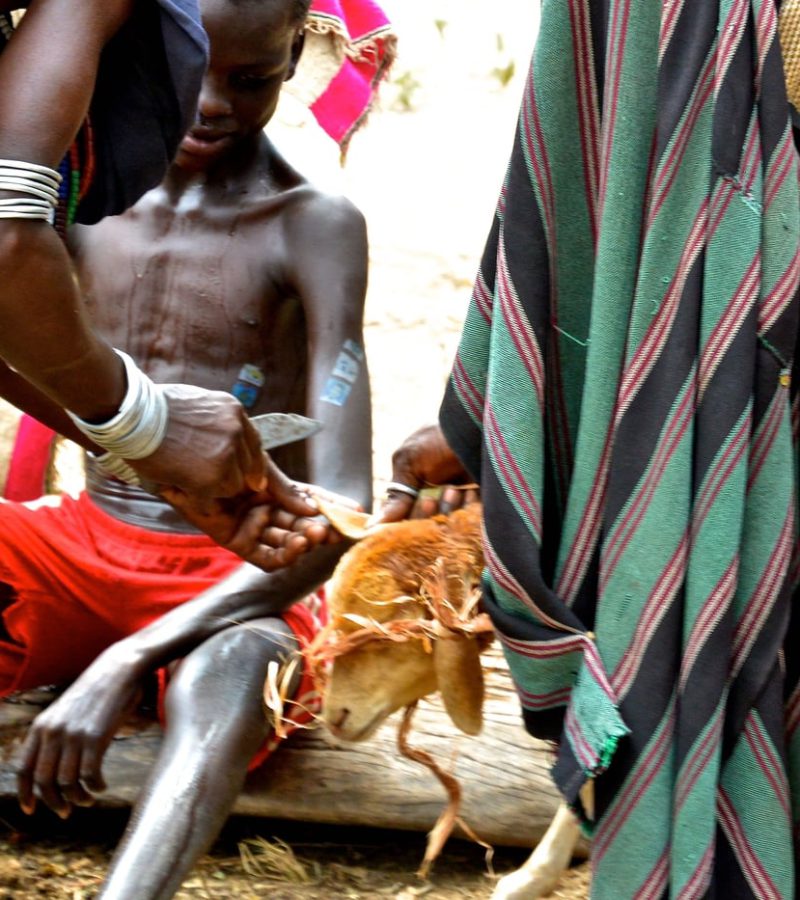
Tradition
Insights
Cutting the female genitalia was a long-established ritual among the Arbore to mark the passage from unmarried girl to bride. The surgery was the norm, not questioned or even criticized. None of those I interviewed, men or women, denied the enormous pain, fear, and pity of daughter, sister, or girlfriend. However, elimination from their cultural customs seemed inconceivable to almost all of them. What else should distinguish girls from women, respectable from prostitutes, strong from weak or Arbore from strangers?
In no society are traditions and rituals static. They are constantly in a state of social change. We experience new things, compare, evaluate and rethink. That is why the great opportunity is in changing the FGC ritual, not in prohibiting it.
The Arbore people seized this chance. On October 20th, 2013, after more than a decade of dialogue, they officially abolished cutting during the wedding ritual at a large event attended by the local media. Instead of the clitoris, the tip of a goat's ear now is cut. That was their decision.
Borderless?
Female Genital Cutting (FGC) is practiced in approximately 41 countries worldwide in very different ways. The procedure is an expression of social control and standardization. It is used to mark a girl's (usually later) marriageability. The painful marking is hidden, irreversible and unambiguous. This alone gives the girl social approval for later sexual activities.
The practice of female genital cutting has no boundaries - neither geographical, religious nor social. The only identifiable boundary is the ethnic group itself.
Percentage distribution of FGC

Distribution of FGC by religion
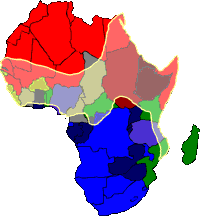
Distribution of FGC according to AIDS-RATIO
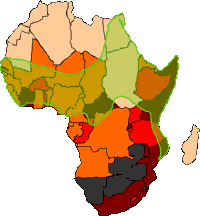
Legend FGC-RATIO | ||
| 0 | |
|
| < 5% |
|
| 5% to 30% |
|
| 31% to 80% |
|
| 81% to 100% |
|
| in certain regions infibulation |
|
| predominantly infibulation (countries) |
Legend Religion | ||
|
| Christianity - Islam - Indigenous |
|
| Christianity |
|
| Christianity - Islam |
|
| Christianity - Indigenous |
|
| Islam |
|
| Islam - Christianity |
|
| Islam - Indigenous |
|
| Indigenous - Christianity |
|
| Indigenous - Islam |
|
| 'Belt of FGC' |
Legend AIDS - RATIO | ||
|
| 0 to 1% |
|
| > 1% to 5% |
|
| > 5% to 10% |
|
| > 10% to 15% |
|
| > 15% |
|
| 'Belt of FGC' |
Women's Talks
A.P.: "How much cattle does the fiancé have to pay?"
ingó: "Ten goats and sheep he gives to the bride's father. In addition, four cattle. Four more cattle are distributed in the family of the utanté. During the sud - ceremony, all eight cattle are slaughtered. The father receives four sacks of coffee. The clan elder receives 20 calabashes of honey, from which daadi [a kind of mead] is later brewed. The fiancé must buy gold [brass] bangles for his bride's upper arms."
A.P.: "When is kandiy [cutting]?"
ingó: "In the afternoon, because at night is slaughtered. Look, there my friend Go'o has cut the utanté Gallé."
A.P.: „Wieso Go’o? Ist sie eine Beschneiderin? War ihre Mutter Beschneiderin?“
ingó: "Go'o is a circumciser. Her mother didn't cut. We women of the Arbore learn to cut by watching, and those who are not afraid become circumcisers. They just say it. The village of Gondarab has four circumcisers.
A.P.: "Tell me about the custom of utanté! What happens there?"
ingó: "Kandiy is here in the bride's house, here in the bara. It's all full, full of people. With women. The mother goes away, far away. She hurries, she is afraid. The neighbors hold the bride. The bride drinks daadi, the holding women drink. Then the circumciser also drinks. The bride is drunk from the daadi. Harraké [high-proof alcohol], however, is bad. A cloth is put over her head, over her mouth, so that the crying cannot be heard. The hut is full of girls and women. They sing loudly and drink daadi."
A.P.: "Is the bride sitting on the ground?"
ingó: "No, she's sitting on this little chair, her legs forward.
A.P.: " Like this? (I sit down on the stool and straddle my outstretched legs).
ingó: "Like this, yes exactly like this. (Laughter) To a neighbor, "Look, ege Till knows how to sit down!" "The arms are held behind."
Ingó and the woman next door demonstrate it on me. In the meantime, children and other neighbors have gathered in the hut. It is as if we are performing a stage play.
A.P.: "What do you do with the cut flesh, with hooli [clitoris, the naked]?"
ingó: "Next to the fireplace in the bara is a hole. This is the grave of hooli. The bride is sitting in front of the hole with her legs stretched out, and hooli and blood are falling into the grave."
A.P.: "Are the girls afraid?"
ingó: "Yes, they run away. But they come back. Every girl wants to get married. Alone out there she would die or become fuuga [a slut m.E.]."
A.P.: "What happens after cutting?"
ingó: "The cut is being checked. After that, all uta go to the house of the clan elder. Only the new one bride is carried to her in-laws' hut. She does not go out of this house for a month. Her legs are tied together so that the wound heals well. Her excrements are buried in the hut. After that is slaughter and dance. All uta are drunk. They beat the cattle of the young husband (...)
Diary of the field research April 11th, 1999, excerpt from: Chiffrierte Körper - Disziplinierte Körper ( PhD thesis).
4 Spots
Daily life and rituals
